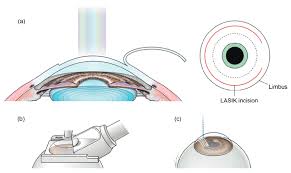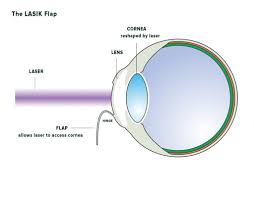Table of Contents
ToggleIntroduction
Adventurers who indulge in skydiving experience the thrilling adrenaline rush of freefalling from great heights. The thought of skydiving may cause some anxiety for people who have had LASIK vision correction. But now that LASIK is more widely used and eye care technology has advanced, it’s important to answer the query, “Can you skydive after LASIK?” The safety of skydiving after LASIK, potential hazards, essential safeguards, and testimonies from those who have successfully combined both experiences are all covered in this article.
Recognising LASIK
Myopia (nearsightedness), hyperopia (farsightedness), and astigmatism are common vision issues that can be treated with LASIK or Laser-Assisted In Situ Keratomileusis. A surgeon uses a laser to cut a tiny flap on the cornea to enhance how light enters the eye and concentrates on the retina during LASIK. The underlying corneal tissue is then reshaped. It is a popular option for vision correction since it is rapid, often painless, and successful.
Skydiving’s physical demands include
Understanding the physical demands of the activity is crucial before exploring how skydiving and LASIK might coexist. High-speed freefall, abrupt variations in air pressure and temperature, and the need for safety eyewear during the jump are all aspects of skydiving. People who have just undergone LASIK surgery may be concerned about these variables since they can affect the eyes.
When Can You Skydive After LASIK?
The recovery period is among the most important considerations when skydiving after LASIK. After LASIK, patients often notice better vision within 24 hours, although it may take a few weeks for the eyes to stabilise completely. It takes time for the LASIK-created corneal flap to firmly attach to the eye’s surface. For at least two to four weeks following surgery, eye care specialists often advise not engaging in high-impact sports, including skydiving, to ensure maximum safety.
Consultation with an Eye Care Specialist
Speaking with your eye care specialist before starting any physically demanding activity following LASIK, including skydiving, is essential. They will evaluate your situation, consider how you are recovering from surgery, and advise whether it is safe to go skydiving or engage in other comparable activities. To ensure that your eyes have recovered enough and that the danger of problems is kept to a minimum, consult an eye care practitioner.
Potential Risks and Safety Measures
Even while skydiving is typically risk-free after LASIK when you follow your eye doctor’s advice, there are still potential concerns to be aware of:
Skydiving might temporarily dry your eyes because of increased wind and air pressure. Recent LASIK patients may suffer modest dry eye symptoms throughout the recovery process. Artificial tears can be used before and after the jump to lessen the possibility of aggravating dry eye.
Use of Goggles:
Skydiving goggles are needed to protect your eyes when freefalling. However, some people may discover that wearing goggles puts strain on their eyes, which can be uncomfortable. Talk with your skydiving instructor about other goggles alternatives if you feel discomfort.
Risk of Infection:
As with any activity, there is little possibility of developing an eye infection when exposed to unfamiliar surroundings. This danger can be reduced by practising good hygiene, refraining from contacting your eyes with unwashed hands and maintaining clean eyewear.
UV Protection:
At greater altitudes during a jump, you are more exposed to the sun’s dangerous UV rays. It would be best to use UV-protective eyewear, such as sunglasses or UV-filtering goggles, to protect your eyes.
Skydivers with LASIK have provided their feedback:
Many people who have had LASIK have been able to effectively mix their love of skydiving with their newly discovered flawless eyesight. These skydivers frequently praise the amazing sensation of seeing the world clearly from above without the limitations of spectacles or contact lenses in their testimonials. They stress how crucial it is to heed the advice of their eye doctor, put on the correct safety gear, and lubricate their eyes properly before jumping.
Can you skydive after LASIK?
Yes, you can jump after LASIK in the majority of situations. It is essential to heed the advice of your eye care specialist and adopt the appropriate safety measures. High-impact sports, like skydiving, must be avoided during this healing phase for the corneal flap to cling firmly.
You can think about skydiving if your eye doctor says your eyes have recovered enough and your eyesight is steady. Remember that skydiving entails rapid freefall while subjected to fluctuating air pressure and wind. Artificial tears can assist in reducing discomfort before and after the leap, as this could temporarily dry up the eyes.
It’s essential to wear the proper goggles. Make sure the goggles are comfortable to wear and do not put any strain or pain on your eyes. Additionally, consider using UV-protective eyewear like UV-blocking sunglasses or goggles to protect your eyes from damaging ultraviolet radiation at higher altitudes.
Skydiving may be an amazing experience after LASIK, letting you experience the rush of the sport with improved vision and independence from glasses or contact lenses. Many people who have had LASIK along with skydiving frequently comment how happy they are to have flawless eyesight when viewing the globe from above.
Conclusion
You shouldn’t be able to enjoy the exhilarating experience of skydiving with excellent vision as long as you wait for the requisite healing period, speak with an eye care specialist, and take the essential measures during the jump. To ensure a safe and happy time in the air, always put your eye health first and follow the recommendations of your eye care specialist. If you’ve ever imagined experiencing the ultimate freedom of skydiving, LASIK may be the solution.













